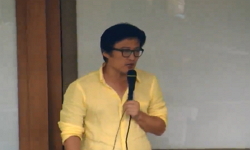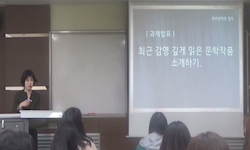In this paper, I have attempted to assess changes in the texts produced by the Korean film industry. Film texts in recent years increasingly feature female characters who resist conventional gender roles. That is, alternative and even subversive image...
http://chineseinput.net/에서 pinyin(병음)방식으로 중국어를 변환할 수 있습니다.
변환된 중국어를 복사하여 사용하시면 됩니다.
- 中文 을 입력하시려면 zhongwen을 입력하시고 space를누르시면됩니다.
- 北京 을 입력하시려면 beijing을 입력하시고 space를 누르시면 됩니다.
https://www.riss.kr/link?id=A76149187
- 저자
- 발행기관
- 학술지명
- 권호사항
-
발행연도
2004
-
작성언어
Korean
- 주제어
-
등재정보
KCI등재후보
-
자료형태
학술저널
- 발행기관 URL
-
수록면
423-446(24쪽)
-
KCI 피인용횟수
3
- 제공처
-
0
상세조회 -
0
다운로드
부가정보
다국어 초록 (Multilingual Abstract)
In this paper, I have attempted to assess changes in the texts produced by the Korean film industry. Film texts in recent years increasingly feature female characters who resist conventional gender roles. That is, alternative and even subversive images of women's desires have become more widespread recently, with the writings on the films 〈sassy girl〉 and 〈my wife is a gangster〉 generating perhaps the most attention.
I ask how and why images of feminine power and desire become marketable products in the increasingly competitive field of film industry. In this study, I show how the changing structure of the film industry accommodate, nurture, and even benefit from the circulation of transgressive images of feminine desire. I also ask in what ways textual change has then had reciprocal effects on the film industry and the audience. These questions have Jed me to investigate the actual forces at work in the film industry and their intertextual relations to symbol creators and the audience.
The overall conclusion I make from this paper is that the ownership of the film industry does not necessarily guarantees its control of text. 111is is because cultural conditions are always shifting and unstable. Consequently, the film industry has to meet the needs of the audience in order to secure its profit. The condition, in tum, creates space in which film can serve as a site for reimagining social relations during periods of cultural and political change. It also leads us to rethink the assumptions about its homogenizing power, making us instead explore this terrain as a site of contest, and a productive space within civil society.
목차 (Table of Contents)
- 영화산업: 문화와 산업의 복합체
- 텍스트의 변화와 산업전략
- 영화시장의 분절화
- 장르변화와 텍스트의 차별화
- 텍스트 변화와 관객
- 영화산업: 문화와 산업의 복합체
- 텍스트의 변화와 산업전략
- 영화시장의 분절화
- 장르변화와 텍스트의 차별화
- 텍스트 변화와 관객
- 텍스트의 변화: 산업과 관객의 산물
- 참고문헌
동일학술지(권/호) 다른 논문
-
- 한국영화학회
- 김금동(Kim Keum-Dong)
- 2004
- KCI등재후보
-
- 한국영화학회
- 김남수(Kim Sunam)
- 2004
- KCI등재후보
-
- 한국영화학회
- 김시무(Kim Seemoo)
- 2004
- KCI등재후보
-
- 한국영화학회
- 김정호(Kim Jung Ho)
- 2004
- KCI등재후보
분석정보
인용정보 인용지수 설명보기
학술지 이력
| 연월일 | 이력구분 | 이력상세 | 등재구분 |
|---|---|---|---|
| 2026 | 평가예정 | 재인증평가 신청대상 (재인증) | |
| 2020-01-01 | 평가 | 등재학술지 유지 (재인증) |  |
| 2017-09-22 | 학회명변경 | 영문명 : Film Studies Association Of Korea (Fisak) -> Korean Cinema Association (KCA) |  |
| 2017-01-01 | 평가 | 등재학술지 유지 (계속평가) |  |
| 2013-01-01 | 평가 | 등재 1차 FAIL (등재유지) |  |
| 2010-01-01 | 평가 | 등재학술지 유지 (등재유지) |  |
| 2007-01-01 | 평가 | 등재학술지 선정 (등재후보2차) |  |
| 2006-04-09 | 학술지등록 | 한글명 : 영화연구외국어명 : Film Studies |  |
| 2006-01-01 | 평가 | 등재후보 1차 PASS (등재후보1차) |  |
| 2004-01-01 | 평가 | 등재후보학술지 선정 (신규평가) |  |
학술지 인용정보
| 기준연도 | WOS-KCI 통합IF(2년) | KCIF(2년) | KCIF(3년) |
|---|---|---|---|
| 2016 | 0.58 | 0.58 | 0.59 |
| KCIF(4년) | KCIF(5년) | 중심성지수(3년) | 즉시성지수 |
| 0.58 | 0.55 | 1.055 | 0.29 |






 DBpia
DBpia






